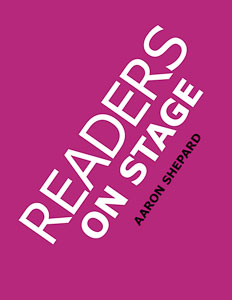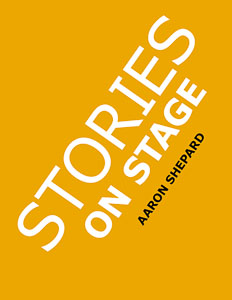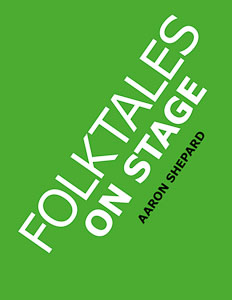Here are just a few recommended script collections, other books, and articles for reader’s theater (or readers theatre). Most links are for more info at Amazon.com, an affiliate.
Resources for Reader’s Theater (or Readers Theatre), With Tips, Scripts, and Worksheets, or How to Use Simple Children’s Plays to Build Reading Fluency and Love of Literature, by Aaron Shepard, Shepard Publications, 2004. Everything you need to start or go further with reader’s theater.
Stories on Stage: Children’s Plays for Reader’s Theater (or Readers Theatre), With 15 Scripts From 15 Authors, Including Louis Sachar, Nancy Farmer, Russell Hoban, Wanda Gag, and Roald Dahl, Second Edition, by Aaron Shepard, Shepard Publications, 2005. The premier collection of reader’s theater scripts, with adaptations of stories by a variety of authors. Mostly for ages 8 to 15.
Folktales on Stage: Children’s Plays for Reader’s Theater (or Readers Theatre), With 16 Scripts from World Folk and Fairy Tales and Legends, Including Asian, African, and Native American, by Aaron Shepard, Shepard Publications, 2004. Scripts based on my own picture books and stories. Mostly for ages 8 to 15.
Readers Theater for Building Fluency: Strategies and Scripts for Making the Most of This Highly Effective, Motivating, and Research-Based Approach to Oral Reading, by Jo Worthy, Scholastic, 2005. A fine introduction to reader’s theater in the classroom, with detailed instructions, plus the theory behind how and why it works—all in a brief, lively, easy-to-read presentation. Grades 3–6.
Readers Theatre for Beginning Readers, by Suzanne I. Barchers, Teacher Ideas Press, 1993. Twenty-four scripts of folktales and fables from around the world, plus tips on reader’s theater in the classroom. Grades 1–4. One of many reader’s theater titles by this author.
Frantic Frogs and Other Frankly Fractured Folktales for Readers Theatre, by Anthony D. Fredericks, Teacher Ideas Press, 1993. Fiercely funny flummery for grades 4–8. Kids love this kind of stuff! One of many reader’s theater titles by this author.
Read! Perform! Learn!: 10 Reader’s Theater Programs for Literacy Enhancement, by Toni Buzzeo, Upstart Books, 2006. Ten scripts adapted from picture books, plus lesson plans and materials for extending the study of each script into numerous curriculum areas. For grades K–5.
From the Page to the Stage: The Educator’s Complete Guide to Readers Theatre, by Shirlee Sloyer, Teacher Ideas Press, 2003. Just what the subtitle says, plus sample scripts. Elementary and middle grades.
Presenting Reader’s Theater: Plays and Poems to Read Aloud, by Caroline Feller Bauer, H. W. Wilson, 1987. Scripts adapted from a variety of children’s authors, plus advice. Primary grades.
Institute Book of Readers Theatre: A Practical Guide for School, Theater, & Community, by William Adams, Institute for Readers Theatre, 2003. A university-level textbook from a bastion and pioneer of reader’s theater. The most comprehensive treatment of reader’s theater available.
How and Why Stories for Readers Theatre, by Judy Wolfman, Teacher Ideas Press, 2004. Forty scripts based on a multicultural selection of pourquoi tales, for grades 1–5. Includes basic reader’s theater info.
Writing Camp: A Reader’s Theater Adventure for Young Writers, by Melissa Forney, Buttery Moon Multimedia, 2010. Nineteen scripts about a group of contemporary kids at summer camp, with related writing exercises. Best ordering may be from the author, at www.melissaforney.com.
Multicultural Folktales for the Feltboard and Readers’ Theater, by Judy Sierra, Oryx, 1996. Short and simple scripts by a popular children’s author. Grades 3–8.
Great Moments in Science: Experiments and Readers Theatre, by Kendall Haven, Teacher Ideas Press, 1996. Combines scripts about famous scientists with experiments that demonstrate the principles they discovered. Grades 4–9.
Readers Theatre Strategies in the Elementary Classroom, 1990, and Readers Theatre Strategies in the Middle and Junior High Classroom, 1997, by Lois Walker, Take Part Productions. Include tips on several different styles of reader’s theater, plus ways to tie in to storytelling, writing, and creative drama. Lois is a leading proponent of reader’s theater in Canada, as well as a workshop leader, script publisher, and children’s television producer.
Learning with Readers Theatre: Building Connections, by Neill Dixon, Anne Davies, and Colleen Politano, Peguis, 1996. A comprehensive approach to using reader’s theater in the classroom, from scripting to performance. Neill Dixon is the head of Readers Theatre International in Canada.
Readers Theatre Handbook: A Dramatic Approach to Literature, by Leslie Irene Coger and Melvin R. White, Scott, Foresman, 1982. Techniques and some scripts, drawn from the early days of reader’s theater. College.
Mel White’s Readers Theatre Anthology: A Collection of 28 Readings, by Melvin R. White, Meriwether, 1993. College.
Be a Mime!, by Mark Stolzenberg, Sterling, 1991 (originally published as Exploring Mime). A good beginning book on mime techniques. A bit of mime can do wonders for reader’s theater!
The Mime Book, Second Edition, by Claude Kipnis, Meriweather, 1988. A thorough book of mime techniques.
“Taking It to the Stage With Readers Theater,” by Marybeth Kozikowski, School Library Journal, Apr. 2015. On reader's theater in the library and classroom.
“The Power of Reader’s Theater,” by Jennifer O. Prescott, Instructor, Jan.–Feb. 2003. Encouragement and advice from teachers using RT.


